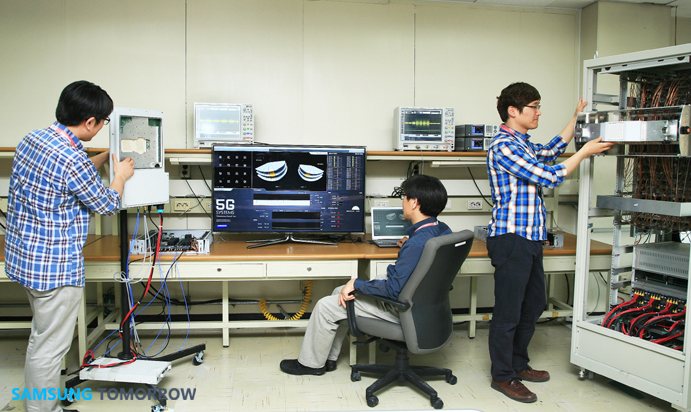Samsung Claims First in 5G Wireless Networking Tech
Samsung says it has successfully tested technology that will be at the core of 5G mobile connectivity.
Samsung announced on Monday that it has successfully developed the world’s first adaptive array transceiver technology operating in the millimeter-wave Ka bands for cellular communications. This tech will be at the core of 5G mobile connectivity, and promises data transmissions up to "several hundred times faster" than current 4G LTE networks.
Unfortunately, it will be 2020 before an actual 5G service will be available on a consumer level. That projection mirrors a target set by the European Union which revealed a plan earlier this year to invest €50 million in research to deliver 5G mobile technology by 2020.
"Samsung’s latest innovation is expected to invigorate research into 5G cellular communications across the world; the company believes it will trigger the creation of international alliances and the timely commercialization of related mobile broadband services," the company stated.
Samsung said its new adaptive array transceiver tech uses 64 antenna elements, and transmits data in the millimeter-wave band at a frequency of 28 GHz at a speed of up to 1.056 Gbps to a distance of up to 2 kilometers. Additional reports claim the tech will reportedly enable upload and download speeds of up to 10 Gbps compared to the 75 Mbps speeds seen on fourth-generation long-term evolution (4G LTE) networks.
Samsung believes this new tech can be a viable solution for overcoming the radio propagation loss at millimeter-wave bands, much higher than the conventional frequency bands ranging from several hundred MHz to several GHz.
"Samsung’s new technology will allow users to transmit massive data files including high quality digital movies practically without limitation," the company said. "As a result, subscribers will be able to enjoy a wide range of services such as 3D movies and games, real-time streaming of ultra high-definition (UHD) content, and remote medical services."
Maybe by 2020 the majority of consumers worldwide will have finally jumped on the 4G LTE-Advanced bandwagon, which launches later this year, just in time for the 5G network launch. It will be like getting a sparkly new, cutting-edge phone and the successor arrives just a month later.
Get Tom's Hardware's best news and in-depth reviews, straight to your inbox.

Kevin Parrish has over a decade of experience as a writer, editor, and product tester. His work focused on computer hardware, networking equipment, smartphones, tablets, gaming consoles, and other internet-connected devices. His work has appeared in Tom's Hardware, Tom's Guide, Maximum PC, Digital Trends, Android Authority, How-To Geek, Lifewire, and others.
-
blubbey Reply10811765 said:Are unlimited data plans making a comeback or will I blink and be over the limit?
If you're downloading games maybe. -
dimar First we need an international law to make any type of bandwidth cap illegal. What's the point of 4G 5G or 10,000G if it will eat your data plan in a few seconds?Reply -
blackened144 This is useless if still I have to get up from my desk and walk to a window to get a signal..Reply -
therabiddeer I can see it now:Reply
"Are you tired of waiting minutes or even HOURS to hit your bandwidth cap? Well, have no fear because the wait is over! With new and improved 5G you can hit your cap in mere seconds! All for only $200 down and $55 monthly payments! Call today!" -
bustapr chances are very likely that by 2020, bandwidth caps will be much more forgiving than today and signal strength will be more advanced. 2020 is 7 years away, and at the pace comunications tech is evolving, ALOT can happen in this time. I wouldnt really think much about this tech until we actually see it on a consumer level.Reply
also, I didnt really read the article of a few days ago, but wasnt there an article here on THG that stated Mediatek released the first SoC with integrated 5G? -
TheMadFapper "Maybe by 2020 the majority of consumers worldwide will have finally jumped on the 4G LTE-Advanced bandwagon, which launches later this year, just in time for the 5G network launch."Reply
Revise this sentence please, it makes no sense whatsoever. First of all, the major carriers have no plans for LTE-Advanced yet. We're still worrying about LTE deployment and that's an expensive, lengthy process. To put a date on it is ridiculous. Secondly, LTE-Advanced will be marketed as 5G, even though according to the 3GPP it'll be true 4G (and the LTE you know now is 3G). Finally, how are people jumping on a bandwagon in 2020 for a 'later this year launch'. What are you even saying? -
JOSHSKORN They need to focus on hardware. Too many apps running at once slows things down. If they can fix that bottleneck, then we can move on. I think my DROID is in dire need of twice the amount of memory it has for it to run smoothly. Everytime I try to run updates, it's unbearably slow and I can't do anything else.Reply
